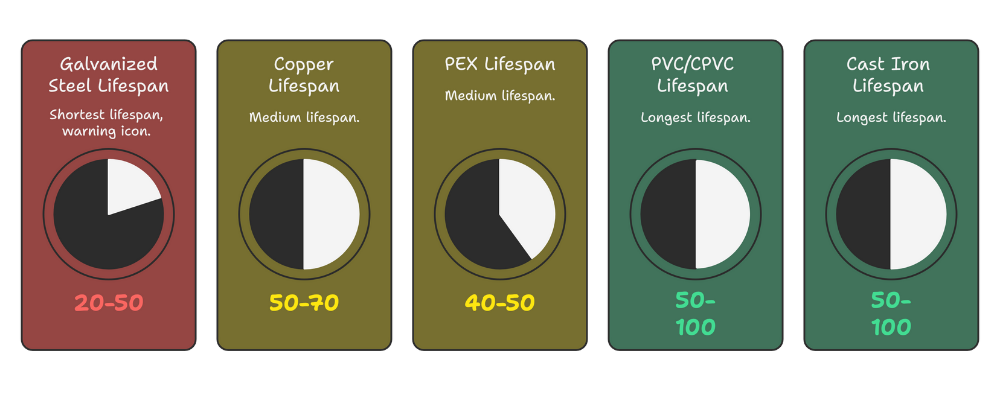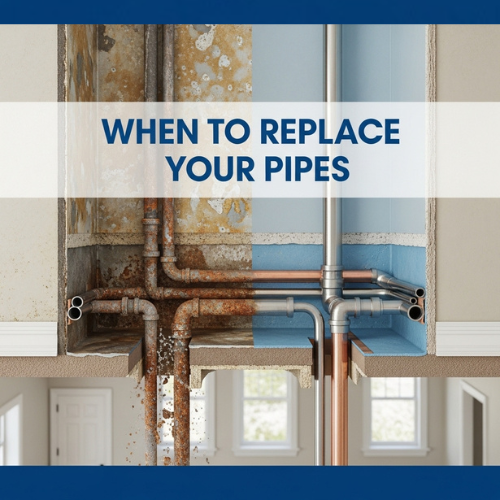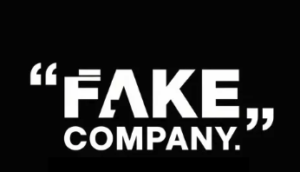TL;DR
Most plumbing pipes have a limited lifespan, and knowing when to replace your pipes can prevent thousands in water damage. Galvanized steel pipes last 20-50 years, copper lasts 50-70 years, and PEX can reach 40-50 years. Twin Falls homeowners should watch for warning signs like low water pressure, discolored water, frequent leaks, and visible corrosion — especially in older homes built before 1980. Regular inspections catch problems early, and understanding your pipe material’s age helps you plan proactive replacements before emergency repairs become necessary.
Most Twin Falls homeowners don’t think about their plumbing until something goes wrong. But here’s the reality: the pipes hidden in your walls and under your floors have a limited lifespan, and when they fail, the damage can be extensive and expensive.
Many Twin Falls homes built before 1980 still rely on galvanized steel or older copper pipes that are nearing — or have exceeded — their expected lifespan. Understanding when to replace your pipes isn’t just about preventing inconvenient leaks; it’s about protecting your home’s value and avoiding catastrophic water damage that can cost tens of thousands of dollars to repair.
At TRW Plumbing, we’ve helped countless Twin Falls families navigate the decision between repair and replacement. This guide will walk you through everything you need to know about pipe lifespans, warning signs of failure, and how to make informed decisions about your home’s plumbing system.
Why Your Plumbing’s Age Matters
Just like your roof, furnace, or water heater, your plumbing pipes have a finite lifespan. Different pipe materials deteriorate at different rates, and understanding what’s in your home is the first step in knowing when replacement might be necessary.
Pipe Lifespan by Material

Here’s what you can expect from common pipe materials found in Twin Falls homes:
Galvanized Steel Pipes: 20-50 Years
Galvanized pipes were the standard in homes built from the 1930s through the 1960s. These steel pipes are coated with zinc to prevent corrosion, but that protective layer gradually wears away. Once the zinc is gone, the steel corrodes rapidly, leading to rust, reduced water pressure, and discolored water. Most galvanized pipes reach critical failure between 40-50 years.
Copper Pipes: 50-70 Years
Copper became the preferred choice from the 1960s through the early 2000s and remains a quality option today. Copper pipes are durable and resistant to corrosion, but they’re not immune to failure. Water chemistry, including the hard water common in Twin Falls homes, can accelerate copper corrosion. Pinhole leaks often develop after 50 years of service.
PEX (Cross-Linked Polyethylene): 40-50 Years
PEX is the modern standard for residential plumbing, gaining popularity in the 1990s and 2000s. It’s flexible, freeze-resistant, and immune to corrosion. While manufacturers claim lifespans of up to 100 years, real-world data suggests 40-50 years is more realistic. Since PEX is relatively new, we’re still learning about its long-term performance.
PVC and CPVC: 50-100 Years
These plastic pipes are commonly used for drain lines and, in the case of CPVC, for hot water supply lines. They’re highly resistant to corrosion and chemical damage, making them exceptionally durable. However, they can become brittle over time, especially if exposed to UV light or extreme temperatures.
Cast Iron Drain Pipes: 50-100 Years
Many older Twin Falls homes have cast iron drain pipes. While incredibly durable, these eventually rust from the inside out, leading to leaks and blockages. Most cast iron pipes need replacement after 50-75 years.
Local Factors That Affect Pipe Lifespan
Twin Falls’ unique conditions can accelerate pipe deterioration:
Hard Water Mineral Content
According to the City of Twin Falls water quality data, our water measures 15-20 grains per gallon (GPG), placing it in the “very hard” category. This high calcium and magnesium content causes:
- Accelerated scale buildup inside pipes
- Reduced water flow over time
- Increased pressure on pipe joints
- Faster corrosion of metal pipes
Temperature Fluctuations
Idaho’s temperature swings — from sub-zero winter nights to 95°F summer days — cause pipe materials to expand and contract repeatedly. This thermal stress weakens joints and can cause cracks, especially in older pipes that have already been stressed for decades.
Soil Conditions
The volcanic soil common in the Magic Valley region can be particularly corrosive to underground pipes. Homes with older galvanized or copper service lines running from the street to the house often experience failures in these underground sections first.
7 Warning Signs You Might Need to Replace Your Pipes
Catching pipe problems early can mean the difference between a planned, controlled replacement and an emergency repair after significant water damage. Here are the red flags every Twin Falls homeowner should watch for:
1. Low Water Pressure in Multiple Fixtures
If you’ve noticed that your shower doesn’t spray as forcefully as it used to, or multiple faucets throughout your home have weak flow, this often indicates widespread pipe corrosion or mineral buildup.
A single fixture with low pressure usually means a clogged aerator or a problem with that specific line. But when pressure drops throughout your home, it suggests your pipes are narrowing from corrosion or scale deposits — a clear sign that replacement is on the horizon.
The hard water in Twin Falls can cause significant scale buildup that mimics these symptoms, so it’s worth having a professional inspect your pipes to determine whether the issue is removable buildup or permanent corrosion.
2. Discolored or Rusty Water
Turn on your faucet and see brown, yellow, or reddish water? This is rust from corroding pipes, most commonly galvanized steel. The discoloration usually appears when you first turn on the water after it’s been sitting in the pipes for several hours (like first thing in the morning).
While occasional discoloration can happen when the city flushes water mains, persistent rusty water indicates your pipes are actively deteriorating. Once you see rust in your water, the corrosion has already progressed significantly, and replacement should be planned soon.
3. Frequent Leaks or Damp Walls
One leak might be an isolated incident. But if you’re calling a plumber multiple times a year to fix different leaks throughout your home, your pipes are telling you they’re at the end of their lifespan.
Watch for these signs of hidden leaks:
- Damp spots on walls or ceilings
- Peeling paint or wallpaper
- Musty odors in certain areas
- Unexplained increases in your water bill
- Warm spots on floors (indicating hot water line leaks)
Multiple leak repairs can quickly exceed the cost of proactive pipe replacement, and each leak risks causing water damage to your home’s structure.
4. Unusual Water Taste or Smell
Metallic-tasting water often indicates corroding pipes leaching metal into your water supply. While Twin Falls municipal water is safe and meets EPA standards, deteriorating pipes can introduce unwanted flavors and potentially harmful contaminants.
A sulfur or “rotten egg” smell can come from either the water source or from bacteria growing in corroded pipes. If neighbors aren’t experiencing the same smell, the problem is likely within your home’s plumbing.
5. Visible Corrosion or Stains on Exposed Pipes
Check the pipes visible in your basement, crawl space, or under sinks. Look for:
- Flaking or discoloration on the outside of pipes
- Green or blue stains (indicating copper corrosion)
- Orange or red rust spots
- White or gray chalky deposits (from hard water)
- Warping or dimpling in the pipe surface
What you see on the outside is usually less severe than what’s happening inside the pipe, so visible corrosion typically means interior deterioration is advanced.
6. Noisy Plumbing
While some plumbing noise is normal, loud banging (water hammer), rattling, or whistling sounds often indicate:
- Loose pipes that have shifted due to corrosion at mounting points
- Pressure fluctuations from narrowed pipe openings
- Air trapped in lines due to poor flow from buildup
- Failing pipe supports
These noises accelerate wear on pipe joints and connections, increasing the likelihood of future leaks.
7. Frequent Clogging or Slow Drains
If multiple drains throughout your home are slow or frequently clog — and professional cleaning only provides temporary relief — the problem may be deteriorating drain pipes rather than simple blockages.
Cast iron drain pipes, common in older Twin Falls homes, rust from the inside, creating rough surfaces that catch debris and eventually narrow the pipe opening. Galvanized pipes can also develop interior roughness as the zinc coating fails.
When to Replace Your Pipes: Understanding the Inspection Process
Professional plumbers use several methods to determine whether repair or replacement is your best option. Understanding this process helps you make informed decisions about your home’s plumbing system.
Professional Inspection Techniques
Video Camera Inspection
Modern plumbers use specialized cameras to inspect the inside of your pipes without cutting into walls. This technology allows us to see:
- The extent of corrosion or scale buildup
- Cracks, holes, or weak spots
- Tree root intrusion in sewer lines
- Overall pipe condition throughout your system
Video inspections typically cost $200-$400 but provide invaluable information about whether localized repairs will suffice or if comprehensive replacement is necessary.
Pressure Testing
This involves temporarily sealing your plumbing system and monitoring pressure levels. Significant pressure drops indicate leaks, even ones too small to see or cause visible water damage yet.
Water Quality Testing
Testing your water can reveal elevated metal levels that indicate advanced pipe corrosion. High iron or copper levels suggest your pipes are actively deteriorating into your water supply.
The 20% Rule
Here’s a practical guideline plumbers use: if 20% or more of your home’s plumbing shows signs of corrosion, failure, or leaks, full replacement is typically more cost-effective than ongoing repairs.
Why? Because once pipes start failing in multiple locations, it indicates systemic deterioration throughout your system. Repairing individual leaks becomes a never-ending cycle as new problems emerge, often causing water damage between repairs.
Typical Replacement Timelines for Idaho Homes
Based on our experience with Twin Falls homes, here are general guidelines for when to consider proactive replacement:
- Homes built before 1960 with original galvanized pipes: Replacement is likely overdue
- Homes built 1960-1990 with original copper: Begin monitoring closely and plan for replacement within 5-10 years
- Homes built 1990-2010 with copper or early PEX: Should have 20-30+ years remaining, but inspect for installation quality issues
- Homes built after 2010 with PEX: Should have decades of service remaining
These are general guidelines — actual pipe condition varies based on water quality, usage, and installation quality.
How Much Does Pipe Replacement Cost?
Understanding the financial investment helps you plan and budget appropriately. While the cost may seem significant, it’s often less than you’d expect and far less than the cost of water damage from failing pipes.
National Pricing Guidelines
According to recent industry data, pipe replacement costs typically range from $150-$250 per linear foot for professional installation. However, whole-house repiping projects usually offer better per-foot pricing.
For a complete home repipe using PEX:
- Small homes (1,000-1,500 sq ft): $2,000-$5,000
- Average homes (1,500-2,500 sq ft): $4,000-$10,000
- Large homes (2,500-4,000 sq ft): $8,000-$15,000
These estimates include:
- Materials (pipes, fittings, valves)
- Labor for installation
- Access to walls and ceilings
- Basic patching and repair of access holes
- Pressure testing and inspection
Twin Falls Local Estimates
In Twin Falls, you can expect pricing similar to national averages, potentially 5-10% lower due to regional cost differences. A typical 2,000 square foot home with two bathrooms and a kitchen usually costs $4,000-$7,000 for a complete PEX repipe.
Factors that affect cost:
- Number of bathrooms and fixtures: More fixtures mean more supply lines
- House configuration: Multi-story homes cost more than single-story
- Accessibility: Finished basements or slab foundations increase complexity
- Pipe material choice: Copper costs 2-3x more than PEX but offers benefits in certain situations
- Water heater location: Distant water heaters require more piping
Cost Comparison: Replacement vs. Ongoing Repairs
Let’s look at a real scenario:
Ongoing Repair Approach:
- Leak repair #1: $300
- Leak repair #2 (six months later): $450
- Water damage from leak #3: $2,500
- Leak repair #3: $400
- Leak repair #4: $350
- Total over 2-3 years: $4,000+ plus stress and water damage
Proactive Replacement Approach:
- Complete home repipe: $5,000
- No more leak emergencies, protected home, increased property value
When you factor in the peace of mind, prevention of water damage, and elimination of emergency repair premiums, replacement often makes financial sense even before pipes reach critical failure.
How TRW Plumbing Helps Twin Falls Homeowners Upgrade Their Plumbing
At TRW Plumbing, we’ve repiped hundreds of Twin Falls homes, and we understand that this is a significant decision for homeowners. We’re here to guide you through the process with transparency and expertise.
Our Comprehensive Approach
Honest Assessments
We’ll never recommend replacement if repairs are a better option for your situation. Our video inspection and pressure testing give you a clear picture of your pipes’ actual condition, and we’ll explain your options in plain language without pressure tactics.
Detailed Planning
Before we start work, we’ll:
- Map out your entire plumbing system
- Identify the most efficient routing for new pipes
- Plan access points to minimize wall and ceiling damage
- Provide a detailed timeline and cost breakdown
- Coordinate with you to minimize disruption to your routine
Quality Installation
We exclusively use quality materials designed for Idaho’s climate and Twin Falls’ water conditions. Our licensed plumbers follow current building codes and best practices, ensuring your new plumbing system will serve your family for decades.
Warranty Protection
Our work is backed by comprehensive warranties covering both materials and labor. You’ll have peace of mind knowing that your investment is protected.
Why Upgrade Matters
Modern plumbing systems offer significant advantages over older pipes:
- Reliability: Decades of worry-free service
- Water quality: No rust, corrosion, or metal leaching
- Efficiency: Better pressure, consistent flow
- Energy savings: Less heat loss in hot water lines
- Home value: Updated plumbing is a strong selling point
If you’ve spotted warning signs of aging pipes, we can help you evaluate whether repair or replacement is the right choice for your home. Our inspection services provide the information you need to make a confident decision.
📞 Call or text us at (208) 410-2044 to schedule your plumbing inspection today — before a small issue becomes a costly emergency.
Frequently Asked Questions About Replacing Old Pipes
How long do pipes last in Twin Falls homes?
Pipe lifespan in Twin Falls varies by material: galvanized steel lasts 20-50 years, copper lasts 50-70 years, PEX lasts 40-50 years, and PVC can last 50-100 years. However, Twin Falls’ hard water (15-20 grains per gallon) can accelerate deterioration, potentially reducing these lifespans by 10-20%. Homes built before 1980 with original plumbing should be inspected regularly, as pipes may already be at or beyond their expected lifespan.
What are the signs I should replace my pipes instead of repairing them?
Replace rather than repair when you experience multiple recurring leaks, consistently low water pressure throughout your home, persistent water discoloration, visible corrosion on exposed pipes, or if your pipes are approaching or have exceeded their expected lifespan. The 20% rule applies: if one-fifth or more of your plumbing system shows deterioration, full replacement is typically more cost-effective than ongoing repairs.
How much does pipe replacement cost in Twin Falls?
Pipe replacement costs in Twin Falls typically range from $4,000-$10,000 for an average 2,000 square foot home with two bathrooms, using PEX piping. Costs vary based on home size, number of fixtures, accessibility, and pipe material choice. While this seems significant, it’s often comparable to or less than the cumulative cost of repeated emergency repairs plus potential water damage. Contact TRW Plumbing at (208) 410-2044 for a free, no-obligation assessment specific to your home.
Does homeowners insurance cover pipe replacement?
Standard homeowners insurance typically doesn’t cover pipe replacement due to age or wear and tear, as this is considered a maintenance issue. However, if sudden pipe failure causes water damage, the resulting damage to your home (floors, walls, belongings) is usually covered, though the pipe repair itself may not be. Some insurers offer equipment breakdown coverage that may help. Review your specific policy or contact your insurance agent for details on your coverage.
What type of pipes should I choose for my home — copper, PEX, or PVC?
For Twin Falls homes, PEX is typically the best choice for water supply lines due to its flexibility, freeze resistance, lower cost, and immunity to corrosion from our hard water. Copper remains excellent but costs 2-3x more. PVC and CPVC work well for drain lines. Your specific situation — budget, home configuration, and preferences — will guide the best choice. TRW Plumbing can help you evaluate options based on your home’s unique needs and Twin Falls’ water conditions.
Can hard water really damage plumbing in Idaho?
Yes, absolutely. Twin Falls water measures 15-20 grains per gallon (GPG), placing it in the “very hard” category — more than twice the threshold for “hard” water. This high mineral content causes scale buildup inside pipes, reducing water flow by 10-15% over time and accelerating corrosion of metal pipes. Hard water can shorten appliance lifespan by 2-4 years and reduce water heater efficiency by up to 30%. Consider a water softener to protect your plumbing investment.
How do plumbers check for pipe corrosion?
Professional plumbers use video camera inspection to see inside your pipes without cutting into walls, revealing corrosion, scale buildup, cracks, and overall condition. We also perform pressure testing to identify leaks, water quality testing to detect elevated metal levels indicating corrosion, and visual inspection of exposed pipes in basements and crawl spaces. These combined methods provide a comprehensive assessment of your plumbing system’s condition and remaining lifespan.
Should I replace all my pipes at once or in sections?
If inspection reveals widespread deterioration, replacing the entire system at once is typically more cost-effective and convenient than phased replacement. You’ll get better pricing, avoid multiple disruptions, ensure consistent materials throughout, and eliminate the risk of new problems in sections you didn’t replace. However, if deterioration is limited to one area (like bathroom supply lines), sectional replacement may make sense. We’ll help you evaluate the most practical approach for your specific situation.
This blog was created with the help of LeadProspecting AI, an intelligent platform that helps businesses generate high-quality, SEO-optimized content tailored to their local market and audience. LeadProspecting AI streamlines content creation while maintaining authentic expertise and local relevance.





